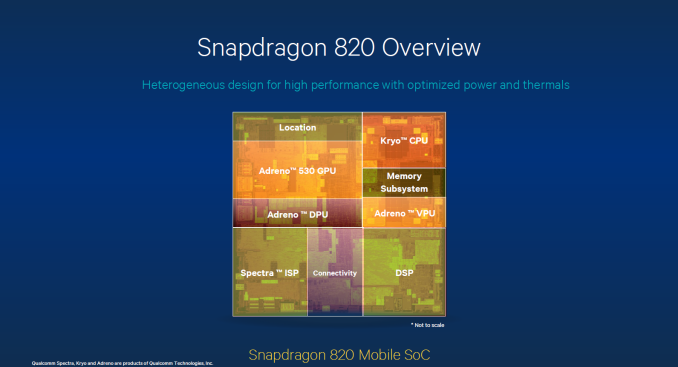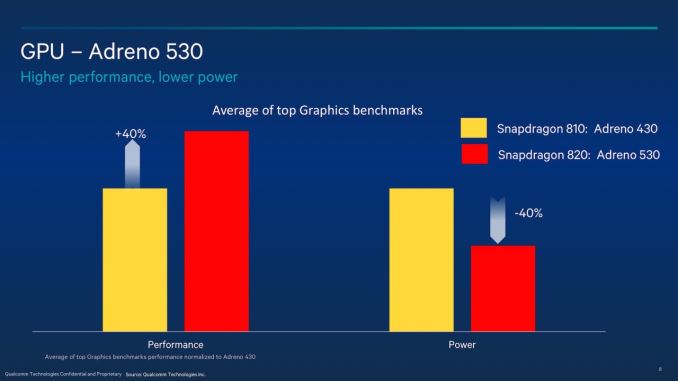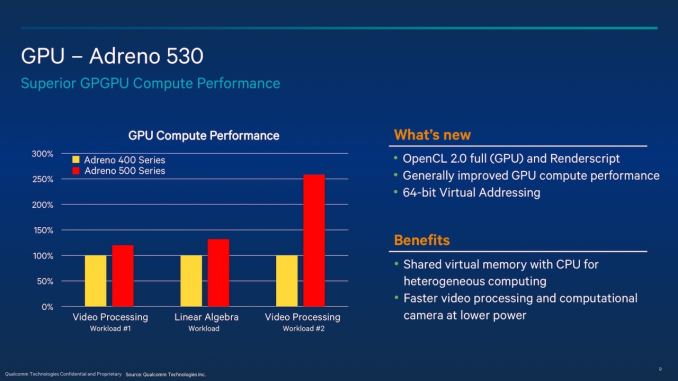Qualcomm Details the Adreno 530 GPU and ISP inside the Snapdragon 820
by Brandon Chester on August 12, 2015 9:35 AM EST- Posted in
- Smartphones
- Adreno
- Mobile
- Tablets
- Snapdragon 820

Snapdragon 820 is still a mystery as far as official information from Qualcomm goes. However, today Qualcomm has given a bit of insight into their upcoming SoC. While there's still no information about the CPU portion featuring Qualcomm's custom 64-bit cores known as 'Kryo', there are some details about the Adreno 510 and 530 GPUs, as well as Qualcomm's Spectra image signal processor.
Because Adreno 530 is their new flagship GPU, Qualcomm's press release focuses more on the 530 than the 510. The performance figures released by Qualcomm describe Adreno 530 as being 40% faster than Adreno 430 on average, while also consuming 40% less power. This result is described as an average of "the top graphics benchmarks", and while it's still generally a good idea to take vendor provided numbers with a grain of salt, if the power and performance gains over Adreno 430 are anywhere in the ballpark of Qualcomm's 40% figure then Adreno 530 should end up being quite impressive.
On the API side, Adreno 500 series GPUs will support OpenGL ES 3.1 + AEP (Android Extension Pack), Renderscript, Vulkan, and OpenCL 2.0. With OpenCL 2.0 comes support for Shared Virtual Memory (SVP), which allows an OpenCL host program and a device's kernel to share a virtual address space so access to data structures like lists and trees can be easily shared between the host and GPU. Adreno 530 has varying improvements to GPGPU performance when compared to Adreno 430, but Qualcomm's slides show video processing as demonstrating the greatest improvement with a 2.5x increase in compute performance. This is also the area where efficiency gains for generational improvements typically happen, so we expect fixed-function codec support although this information is not yet provided.
As for the ISP, it's still the case that mobile image signal processors are black boxes. Qualcomm is stating that their Spectra ISP in Snapdragon 820 will be able to support 3 simultaneous cameras at up to 25MP and at 30fps with no shutter lag. The Spectra ISP will also use MIPI's higher bandwidth C-PHY serial interface, which supports the enhanced camera support. As well as this, new developer and user-facing features include support and APIs for depth maps and using dual cameras to perform refocusing or other visual effects - because Qualcomm is just the SoC manufacturer, it is up to the smartphone OEMs to implement dual-camera/depth-maps as a feature as well.
According to Qualcomm, Snapdragon 820 will start showing up in devices during the first half of 2016. Hopefully between now and then there's more information from Qualcomm about the other aspects of their new SoC, including their Kryo custom CPU core. In Q1 we will be at Mobile World Congress, so we may see more information at that time.












66 Comments
View All Comments
Maxpower2727 - Wednesday, August 12, 2015 - link
Your comment makes me glad that I exclusively use the mobile site. I have no such issues whatsoever.sonny73n - Wednesday, August 12, 2015 - link
"Tom's hardware"... A site I used to visit every night for more than 10 years. They have the most obtrusive ads out of all the tech sites, the in-your-face kind of ads, but I put up with them (not that I had a choice on my mobile iDevices) UNTIL they wrote an article talking about using Adblock is stealing. Lmao... That was about 2 months ago. I immediately deleted their bookmarks on all of my devices and never came back.I hope AT understands that most of readers like myself want to support the sites we visit because we want these sites to stay alive but if we get more craps than materials that we like to see, we will defend ourselves. Because some ad can be very malicious, I'd rather pay for subscription than risk having malwares.
Ryan Smith - Thursday, August 13, 2015 - link
"I hope AT understands that most of readers like myself want to support the sites we visit because we want these sites to stay alive but if we get more craps than materials that we like to see, we will defend ourselves."Indeed we do.
jameskatt - Thursday, August 13, 2015 - link
Forcing us to use 400% more data bandwidth for ads than actual information is STEALING FROM US. We're paying for the bandwidth. It also steals our time from us - forcing us to wait a much longer time before we can read the web page. That is why people resort to using ad blockers.Brandon Chester - Wednesday, August 12, 2015 - link
Most likely a combination of both. It's really hard to say based on the amount of info provided.SpartyOn - Thursday, August 13, 2015 - link
I'd gladly pay $5 a month for an Anandtech subscription without ads. Just my $0.02.$5 is the max I would pay though, since this is an online site and I wouldn't be receiving a physical copy of anything.
jjj - Wednesday, August 12, 2015 - link
Would be nice if the power claim would be clearer. Most of the press and the avg Joe seems to assume peak total power is 40% lower but chances are they are talking power per perf so peak stays flatish. And the 40% claim is "up to" so we'll see.If you factor in for how long the 430 can sustain advertised clocks and that some phones are going 4k, it would be hard to claim that 40% perf gain is impressive, if anything, it's not sufficient at all. Not that others are likely to do better and that's a bit of a problem. Then again, almost nobody tests actual games so people are clueless about what they need from the GPU.
Was more curious about the 510 since we assume it's on 28nm and it's a bit unclear how far they can push.
lilmoe - Wednesday, August 12, 2015 - link
"some phones are going 4k"Totally not needed. I get agitated every time it's mentioned.
jjj - Wednesday, August 12, 2015 - link
That's what some people said about 720p ,then 1080p and 1440p and they'll keep saying it.More is almost always better ,the debatable part is how much better. It also means lower res would become cheaper- that's a huge plus. Today 1080p screens are well bellow 20$, soon enough 1440p will get there if high end goes 4k. In glasses we need higher density so that's another huge plus of the res race in phones. Later on stretchable screens would also benefit from very high pixel density when at min size. So let them race. It's much better than in laptops and tabs where they just stopped, because someone came up with the idea that it's "not needed".lilmoe - Wednesday, August 12, 2015 - link
"More is almost always better"Oh come on. I can, sort of, understand the "economical" aspect of your argument; that lower res panels get cheaper, but there's definitely a point of diminishing returns on screens that "small". 720p to 1080p does NOT have the same visual difference as 1080p to 1440p (or above).
Those who swear by 1440p AMOLED on the GS6 simply say so because Sammy's been using a Pentile matrix for their panels. If their 1080p AMOLED panels had been RGB matrix with similar panel qualities in brightness and color accuracy, then I'd challenge you to tell the difference. No one has seen a GOOD ~5" S-AMOLED 1080p panel with an RGB matrix before, so there's no point of reference for comparison with the current 1440p panel on the GS6.
It's becoming close to impossible to build the perfectly balanced device with all the market demand for "features", specs and other unneeded BS. OEMs are left trying to build their devices to withstand all that pressure instead of focusing on what truly matters. This Snapdragon, as impressive as it sounds, would absolutely SHINE on a device running a GREAT ~5" 1080p panel, top-of-the-line camera sensor, HiFi DAC, UFS, Type-C, and a 3000mah battery. But sadly, these chips are pushed to the extreme limits for no apparent virtue, leaving companies like Qualcomm and Samsung LSI innovating and trying to solve problems that shouldn't even occur in the first place.